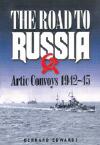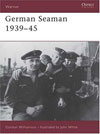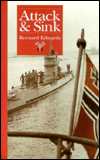The Road to Russia
Arctic Convoys 1942-1945
Edwards, Bernard
2002, Leo Cooper/ Pen and Sword Books
ISBN 0850528984
Hardcover, 224 pages, 18 photos, 1 map
| Type. | General History |
| Pros. | Solid conventional campaign history |
| Cons. | Limited to 1942 only; little new of interest or distinction |
| Rating. |  |
 Bernard Edwards has been writing solid, careful accounts of Second World War naval and merchant history since his retirement from the MN in 1989. Concentrating on short, personalised, mainly MN experiences, he has opened up new material and advanced a new focus on the importance and contribution of merchant navies and commerce warfare. By creating short, commercial readable accounts aimed at the generalist, not the afficionado, Edwards has done much to promote the often maligned and discarded contribution of merchant seamen and the men who escorted them. This focus was largely lacking when he began, 15 years ago. The gradual movement of the MN and the Atlantic Campaign back into the centre of portrayal and representation of Second World War strategy and popular awareness is partly to his credit. It has been a long and hard road to give these men their due, compared to Fighter Command, paratroopers, and Normandy (all of whom depended totally on the merchant navies for their petrol food and ammunition). It is now all but accomplished. General histories of the war, and campaign histories of all areas, now include however brief and brisk summaries of the Atlantic Campaign.
Bernard Edwards has been writing solid, careful accounts of Second World War naval and merchant history since his retirement from the MN in 1989. Concentrating on short, personalised, mainly MN experiences, he has opened up new material and advanced a new focus on the importance and contribution of merchant navies and commerce warfare. By creating short, commercial readable accounts aimed at the generalist, not the afficionado, Edwards has done much to promote the often maligned and discarded contribution of merchant seamen and the men who escorted them. This focus was largely lacking when he began, 15 years ago. The gradual movement of the MN and the Atlantic Campaign back into the centre of portrayal and representation of Second World War strategy and popular awareness is partly to his credit. It has been a long and hard road to give these men their due, compared to Fighter Command, paratroopers, and Normandy (all of whom depended totally on the merchant navies for their petrol food and ammunition). It is now all but accomplished. General histories of the war, and campaign histories of all areas, now include however brief and brisk summaries of the Atlantic Campaign.
Road to Russia: Arctic Convoys 1942, his latest offering, continues this trend, revealing new MN stories and accounts which are blended into careful and effective descriptions and summaries of naval strategy and individual convoys. The newly described accounts of individual seamen’s experiences are valuable, and Edwards provides a useful, easily accessible method of collecting, editing and distributing these for the researcher or reader.
However, beyond this, descriptions of and tales from Loch Ewe, the bleak Scottish convoy terminal, and a few rarely published photos, this work does little for the subject matter or overall history of the campaign. Ship by ship and convoy by convoy, the conventional description proceeds chronologically, covering the inevitable geography and weather, the Nazi-Soviet Non-Aggression Pact, the German invasion, and then the steadily growing intensity and commitment to the convoy route by both sides. The discussion of the culture and events at Loch Ewe, the only original point for this book, raise it above the mediocre. Loch Ewe has long been ignored for the shocking contrast of British ports and the terrible privation and conditions of Murmansk and Archangel. It is good to see Loch Ewe, its tavern and people, its position in the emotional and historical landscape. It compares well to a pub beside a bomber airfield in Lincolnshire, in terms of its position and viewpoint in the story, and its place in the heart of the seamen. It saw so many come and go, and so many not return. A thematic or topical approach using this and the ‘new’ stories of merchant seamen might have made a more interesting, diverse read, but Edwards is otherwise stodgily conventional. He limits himself to one new introductory idea, one concept, in the reassuringly familiar genre. Some stories might not have seen print before, but they are little different or original compared to those published ten, twenty or fifty years ago, when secondary accounts of the ‘Kola Run’ began to appear. Like the 18 photos, they all date from the time and place; all are wrapped in the conventions and style of the period. It is always good to see rare, unusual or unseen images in print, given that there are no ‘new’ images to see: they were all taken in 1939-45 and even if unreleased, cannot be described as ‘new’. Some of these images have not seen the light of day since the late 1940s, and some not since Irving’s infamous account of 1968, but they are not new. Their quality is also disappointingly poor. True, some were taken in poor light or with poor stock, perhaps affected by cold and a delay of months between exposure and processing, but several are stock or known shots as used by Irving, where their quality was excellent. It is important to see these events, places, and men’s faces clearly and well. It is a pity to see them, in such a well-printed and bound volume, so poorly reproduced.
In summation, Road to Russia, in focussing, for publisher’s reasons, on one hard year out of three, not telling the complete story of the arctic convoys, nor telling them in a sufficiently new or effective way, has contributed little to study. Others have done better before, save for the Loch Ewe material, which deserves a chapter in a longer book, or a journal or internet article. To make it the hook for an entire account is stretching it too far. As a memorial piece it is trying too hard. More coverage might have benefitted beginners or the general public, and better ways of telling the story would have benefitted survivors, relatives, specialists, and beginners alike. Edwards has disappointed in not choosing a more risky, less staid method. This work is readable and accessible, but otherwise no longer good enough.
The reviewer welcomes your comments on this review.
Review written by Ian Campbell, Launceston, Tasmania.
Published on 18 May 2003.
Purchase information: (info) Get The Road to Russia now at amazon.co.uk
Get The Road to Russia now at amazon.co.uk
Return to our main review page.



